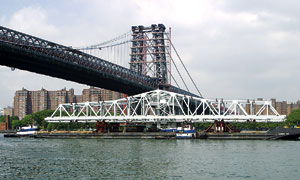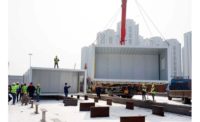 |
The steel behemoth will replace a 107-year-old, 92-meter "camelback" truss that carries some 76,000 daily vehicles from the Bronx to Manhattan, says Paul Connolly, project manager for designer Hardesty & Hanover, New York City. The old bridge straddled two channels at 30-m width clearances.
 |
New York City-based Kiska Construction holds the $118-million replacement contract. Earlier this month, construction crews cut the old 1,800-tonne swing bridge in half before lifting it out.
"The original method for removing the bridge was to jack it up and float it out as one piece," says Henry Perahia, chief bridge engineer for owner New York City Dept. of Transportation. "But it turned out that the actual bridge weighed more than folks thought."
Riding a rising tide that varies about 1.8 m, a barge-mounted 907.2-tonne crane picked each half separately and towed both out. Several hydraulic jacks on a barge will lift the new bridge in one piece a few inches over the center pier and two side piers, and let the falling tide help guide it down into place. After it is bolted down, crews will place a 26.8-m-wide concrete-filled deck.
 |
| SWINGING ALONG Crews split old Third Avenue Bridge into two and removed the halves (top, center). New truss arrived on barge (bottom). (Photos courtesy of Hardesty & Hanover LLP) |
The new 109.5-m-long bridge, fab-ricated by G&G Steel Inc., Russellville, Ala., will add a fifth lane for traffic. Kiska has a $37,500-per-day incentive for up to 30 days to open the bridge before Nov. 24, says Perahia. The daily late penalty is the same, but "were on schedule," Perahia says.
Because of the new bridges greater length, Kiska is building new side piers and modifying the 30.6-m-long, 18.6-m-wide center pier, which consists of a timber caisson and unreinforced masonry. "Its not up to seismic code," says Connolly. That will change with the addition of 10 new support columns of 180-cm-dia drilled shafts as deep as 30 m. Like its predecessor, the bridge will pivot 90° with at least a 7.5-m underclearance for marine traffic. The channel width clearances will increase to 35.5 m.
In the meantime, a two-lane temporary bypass bridge is handling traffic to Manhattan. Crews are installing mechanical and electrical systems on the new bridge and completing widening of the approach roads, with 108 m of work on the Manhattan side and two approaches on the Bronx side, 130 m and 113 m long respectively, says Connolly.
Alternative design possibilities included a fixed span. But the U.S. Coast Guard wanted a movable bridge to accommodate commercial river traffic.
The bridges sister crossing downriver at Willis Avenue, which carries Manhattan traffic to the Bronx, will be ready for replacement when final designs wrap up in a few years, says Perahia.
|



Post a comment to this article
Report Abusive Comment